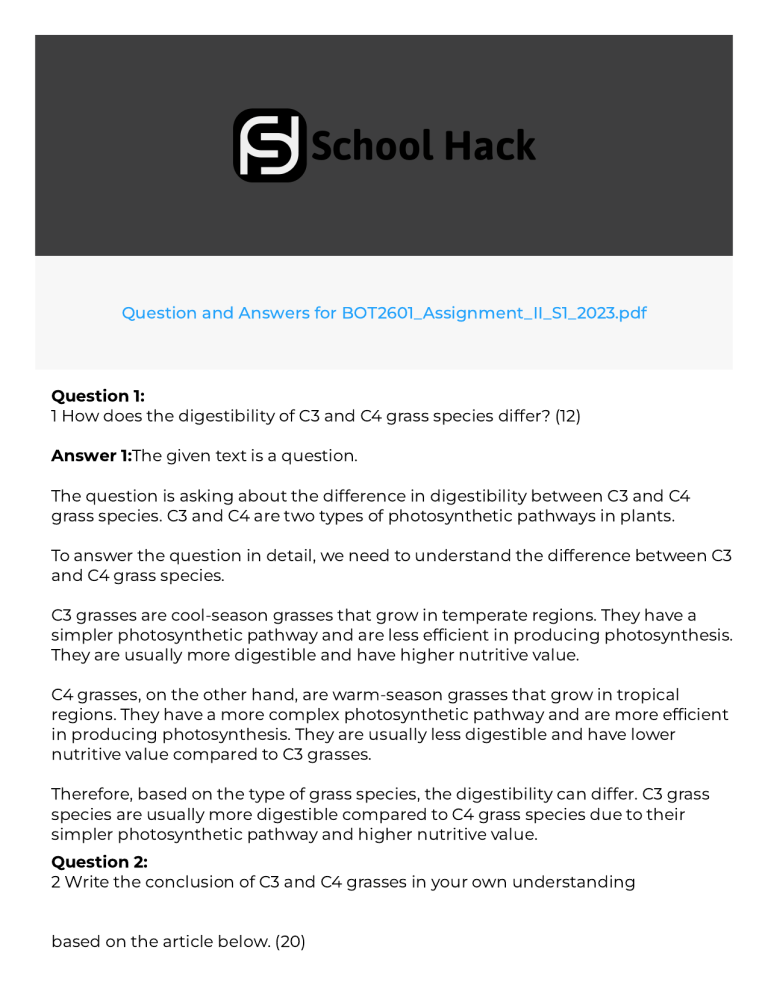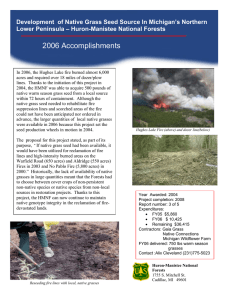
Question and Answers for BOT2601_Assignment_II_S1_2023.pdf Question 1: 1 How does the digestibility of C3 and C4 grass species differ? (12) Answer 1:The given text is a question. The question is asking about the difference in digestibility between C3 and C4 grass species. C3 and C4 are two types of photosynthetic pathways in plants. To answer the question in detail, we need to understand the difference between C3 and C4 grass species. C3 grasses are cool-season grasses that grow in temperate regions. They have a simpler photosynthetic pathway and are less efficient in producing photosynthesis. They are usually more digestible and have higher nutritive value. C4 grasses, on the other hand, are warm-season grasses that grow in tropical regions. They have a more complex photosynthetic pathway and are more efficient in producing photosynthesis. They are usually less digestible and have lower nutritive value compared to C3 grasses. Therefore, based on the type of grass species, the digestibility can differ. C3 grass species are usually more digestible compared to C4 grass species due to their simpler photosynthetic pathway and higher nutritive value. Question 2: 2 Write the conclusion of C3 and C4 grasses in your own understanding based on the article below. (20) TOTAL MARKS = [70] Answer 2:The text is an instruction given to the reader to write the conclusion of C3 and C4 grasses in their own words based on the article provided. The article may have information regarding the differences between C3 and C4 grasses, their characteristics, distribution, and adaptations to different environments. To answer this instruction, the reader needs to go through the article provided and understand the information given about C3 and C4 grasses. They should then summarize the key points in their own words and write a conclusion that highlights the main similarities and differences between these two types of grasses. The reader should also try to explain why these differences matter and what implications they have for the growth and survival of C3 and C4 grasses. Finally, it is important to ensure that the conclusion is well-supported by evidence from the article provided and that it meets the criteria set out in the instructions, such as the word count and the total marks available. Question 3: 1 Do protein levels have an influence the nutrition of C3 and C4 grasses? (10) Answer 3:The following text is a question: "1 Do protein levels have an influence the nutrition of C3 and C4 grasses? (10)" The question is asking whether the protein levels have an influence on the nutrition of two types of grass, specifically C3 and C4 grasses. To answer this question, research needs to be conducted to determine if there is a relationship between protein levels and grass nutrition. It is possible that higher protein levels could lead to better nutrition for the grass, or it may have no effect at all. Further studies can be done to investigate the correlation between protein levels and the nutrition of C3 and C4 grasses. This may require analyzing the chemical composition of the grasses and conducting feeding trials to determine the nutritional value of the grasses with differing protein levels. Overall, the answer to this question is not yet known and requires more research to determine the potential relationship between protein levels and grass nutrition. Question 4: 0 M HCl, as described previously (Barbehenn et al., 2004b). The difference in the amount of sugars (measured with the above procedure) between matched pairs of hydrolyzed and unhydrolyzed samples was defined as fructan. Starch was hydrolyzed with a- amylase and amyloglucosidase in the residue remain- ing after ethanol extraction, and was measured as glucose with a glucose test kit (Hendrix, 1993). All reaction mixtures were scaled to fit in 96-well microtiter plates (200 mL), using a single aliquot (100 mL) of glucose color reagent to measure all sugars in each sample. Absorbance measurements were made with a Bio-Rad Benchmark (Bio-Rad, Hercules, CA, USA) microplate reader at 490 nm. Protein was measured as total amino acids in 6 M HCl hydrolysates with ninhydrin (N 5 10–20/treatment) (Barbehenn, 1995). No correction was made for the small overestimation of protein with this method. Neutral detergent fiber (cellulose, hemicellulose and lignin) was measured gravimetrically after solubilizing and removing non- fiber compounds (N 5 10/treatment) (Van Soest et al., 1991). TNC was defined as the sum of sugars, fructan and starch, while total carbohydrate also included structural carbohydrates (fiber). Leaf toughness was measured on fresh leaves at the time of plant harvest. Toughness was measured with a custom-made penetrometer (Barbehenn et al., 2004b), and was expressed as the mass (g) necessary to punch a 2 mm diameter hole through a leaf (N 5 20/treat- ment). The middle of the first fully expanded leaf was tested, while avoiding thickened midribs. Leaves of B. dactyloides were too narrow to measure with our penetrometer. Statistical analysis Measures of the nutritional quality of five C₃ vs. five C₄ grasses were compared by split-plot nested ANOVA, with photosynthetic pathway, grass species (nested within photosynthetic pathway) and CO₂ concentration as main effects, and block and CO₂ × block as random effects (PROC MIXED; SAS, 2000). The full model included the photosynthetic pathway × CO₂ concentra- tion interaction (to compare the effect of CO₂ on C₃ vs. C₄ grasses) and the CO₂ concentration × species inter- action (to compare the effect of elevated CO₂ on individual species within each photosynthetic path- way). Small, but significant, differences in some measures were observed between years for L. multi- florum and B. curtipendula (e.g., hexose in both species, sucrose in B. curtipendula, and fructan in L. multiflorum) (Table 1), precluding the pooling of data across years. Therefore, data from 2001 were used for these two species in the overall comparison because of the larger sample sizes available during this year. The normality of residuals was tested with PROC UNIVARIATE (SAS, 2000). Where necessary (hexose, toughness and bio- mass), log transformations were used to normalize the residuals. If residuals could not be normalized (sucrose, fructan and water), the significance of main effects was determined with Kruskal–Wallis tests (Wilkinson, 2000). Kruskal–Wallis tests were also used to compare the ratios of total carbohydrates : protein among the four photosynthetic pathway × CO₂ concentration groups. Pairwise differences within grass species between CO₂ treatments were examined by differences of least-squares means (SAS, 2000), or by Kruskal– Wallis tests when data could not be transformed. Toughness in C₃ and C₄ grasses was compared using ANCOVA, with fiber as the covariate, to compare the slopes of the regression lines (Fig. 3) (SAS, 2000). Results C₃ grasses contained higher levels of hexose sugars (glucose and fructose) and sucrose at ambient CO₂ than did C₄ grasses (Table 1, Fig. 1a, b). By contrast, C₄ grasses contained higher levels of starch at ambient CO₂ than did C₃ grasses. Thus, the levels of TNC (sugars, starch and fructan) were not significantly different between the C₃ and C₄ grasses at ambient CO₂ (Table 1, Fig. 1e). Levels of each of the nonstructural carbohydrates in the C₃ grasses increased significantly under elevated CO₂ (Tables 1 and 3, Fig. 1a–d). Hexose, sucrose, starch and fructan increased 48%, 63%, 63% and 202%, respectively. Storage carbohydrates (starch and fructan) increased most consistently in the C₃ grasses, although in two species in which starch did not increase significantly (F. arundinacea and E. canadensis) sugars increased instead. Although levels of fructan tripled on average in C₃ grasses under elevated CO₂, their absolute levels remained relatively low, constituting no more than 7% dry weight (Table 1, Fig. 1c). Nonstructural carbohydrates in the C₄ grasses in- creased to a smaller extent under elevated CO₂ than they did in the C₃ grasses, producing significant photosynthetic pathway × CO₂ concentration interactions Ⓒ 2004 Blackwell Publishing Ltd, Global Change Biology, 10, 1565–1575 Answer 4:The text is a statement that describes a scientific experiment and its results. The experiment compares the nutritional quality of C₃ and C₄ grasses under ambient and elevated CO₂ concentrations. The levels of hexose sugars, sucrose, and starch were higher in C₃ grasses at ambient CO₂, while the levels of storage carbohydrates (starch and fructan) increased most consistently in C₃ grasses under elevated CO₂. The levels of nonstructural carbohydrates in C₄ grasses increased to a lesser extent under elevated CO₂ than in C₃ grasses, producing significant photosynthetic pathway × CO₂ concentration interactions. The statistical analysis involved a split-plot nested ANOVA, Kruskal-Wallis tests, and ANCOVA, which were used to compare and analyze the data. Question 5: 2 Explain in your own words how do CO2 affects the nutrition of C4 grass? (15) Question 3 Answer 5:The given text is a question. The question asks to explain in your own words, how CO2 affects the nutrition of C4 grass. CO2 is an important component of the atmosphere, but the increasing levels of CO2 can have significant impacts on plant growth and nutrition. C4 grasses are a group of plants that have a unique photosynthetic pathway. These plants are adapted to high-light and warm environments, and they have a different way of conducting photosynthesis, which is more efficient in water conservation. When the levels of CO2 are increased, the stomatal conductance of C4 plants decreases, which leads to less water loss and improved water-use efficiency. The high levels of CO2 can increase the photosynthetic rate of C4 plants and enhance their growth, which can lead to an increase in nitrogen uptake and assimilation. However, prolonged exposure to high levels of CO2 can have several negative impacts on plant nutrition. The increased carbon uptake can lead to a decrease in the levels of other essential nutrients such as nitrogen, potassium, and calcium, which can adversely affect plant growth and development. In summary, the increase in CO2 levels can have both beneficial and detrimental effects on the nutrition of C4 grass, and it depends on the duration and concentration of the CO2 exposure.






